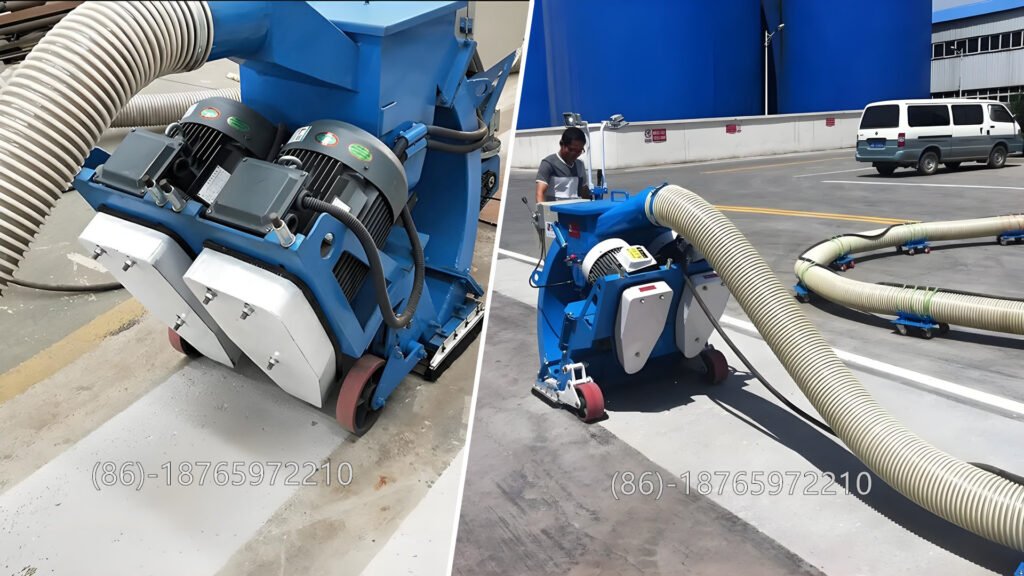Floor shot blasting is a highly effective, mechanized surface preparation method widely used across industrial, commercial, and residential sectors. It leverages centrifugal force to propel abrasive media at high velocity onto a concrete or other hard floor surface, achieving superior cleaning, profiling, and coating removal.
How It Works: The Core Mechanics
- The Machine: A self-propelled or walk-behind shot blasting machine contains a rotating turbine (impeller wheel) housed within an enclosed chamber that seals against the floor.
- Abrasive Media: Steel shot, grit, or other specialized abrasives are fed into the center of the rapidly spinning turbine.
- Centrifugal Acceleration: The turbine blades fling the abrasive particles outward with immense kinetic energy.
- Impact & Rebound: The abrasives strike the floor surface at high speed, dislodging contaminants (dirt, oil, old coatings, weak concrete) and creating a micro-profile. The abrasives then rebound within the enclosed chamber, contributing to the cleaning action.
- Dust Collection: A powerful integral vacuum system immediately sucks up the dislodged debris and spent abrasives, pulling them through a hose into a dedicated dust collector or filter system. This is critical for operator safety and a clean work environment.
- Media Separation & Recycling: A spiral separator inside the machine typically sorts reusable abrasive media from the finer dust and debris. Cleaned abrasives are fed back into the turbine for continued use, maximizing efficiency and economy.
- Surface Result: The process leaves behind a uniformly clean, sound, and optimally profiled surface, essential for excellent adhesion of new coatings, overlays, or toppings.
Key Applications of Floor Shot Blasting:
- Surface Preparation for Coatings: Creating the perfect anchor profile for epoxy, urethane, paints, and other floor coatings.
- Removing Coatings: Efficiently stripping paint, mastics, sealers, epoxy, and thin polymeric overlays.
- Cleaning & Decontamination: Removing oil, grease, dirt, rubber marks (e.g., from forklifts), and curing compounds.
- Creating Slip Resistance: Profiling smooth concrete surfaces to enhance traction.
- Leveling & Smoothing: Correcting minor surface imperfections and smoothing trowel marks or curl-up.
- Restoration: Preparing old, worn concrete for repair or resurfacing. Often used before applying industrial floor hardeners or densifiers.
- Texturing/Exposing Aggregate: Creating decorative finishes by exposing aggregate at various depths (requires careful control).
Major Advantages Over Alternative Methods:
- Superior Efficiency & Speed: Covers large areas significantly faster than manual grinding or scarifying.
- Exceptional Profile Control: Delivers a precise, uniform CSP (Concrete Surface Profile) crucial for coating adhesion. Different abrasives and machine settings achieve varying profiles.
- Consistent Results: Produces a homogeneously prepared surface across the entire floor.
- Dust Control: Integrated vacuum systems capture up to 95-99% of dust at the point of generation, vastly improving air quality and operator safety (respirable silica dust is a major hazard).
- Reduced Labor Intensity: Mechanized process requires less strenuous physical effort compared to handheld tools.
- Versatility: Effective on various concrete conditions and capable of removing many different contaminants/coatings.
- Abrasive Recycling: Significantly lowers abrasive consumption costs.
- Minimal Surface Damage: When operated correctly, it removes only weak material, preserving the integrity of sound concrete substrate.

Important Considerations & Limitations:
- Equipment Cost: Machines represent a significant capital investment, though rental options are widely available.
- Abrasive Cost: While recyclable, abrasive media is a consumable cost.
- Operator Skill: Requires trained operators to achieve the desired profile, avoid over-blasting, and ensure efficient dust collection.
- Surface Moisture: Can be less effective on damp surfaces; concrete needs to be relatively dry.
- Depth Limitations: Primarily a surface treatment. For removing thick layers of material (>1/8″) or significant level correction, scarifying or milling is usually more efficient first.
- Noise & Vibration: Generates significant noise and vibration; hearing protection is mandatory.
- Edge Limitations: Machines typically cannot reach within inches of walls or obstacles; edges often require supplementary hand tools.
Operation & Safety:
- PPE is Essential: Operators must wear respiratory protection (P100/N100 filters at minimum), hearing protection, safety glasses/goggles, gloves, and sturdy boots.
- Dust Collector Maintenance: Filters/collection bags must be serviced/replaced regularly to maintain suction and prevent clogging.
- Abrasive Selection: Choosing the right type (shot vs. grit), size, and hardness is critical for the specific task (coating removal vs. profiling clean concrete).
- Machine Settings: Wheel speed, feed rate, and forward travel speed must be adjusted based on the surface condition and desired result.
In Summary:
Floor shot blasting is the industry-preferred method for efficient, high-quality, and dust-controlled preparation and restoration of concrete floors. Its ability to deliver a consistent surface profile while effectively removing contaminants and coatings makes it indispensable for ensuring the long-term performance and durability of applied floor systems. While requiring proper equipment and trained operators, its speed, effectiveness, and environmental control benefits make it a superior choice for demanding industrial and commercial flooring projects.

